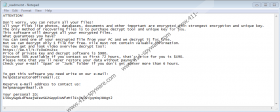Ooss Ransomware Removal Guide
Ooss Ransomware comes uninvited and turns your photos, documents, and data alike into unreadable files. The malware encrypts them with a robust encryption algorithm and the process can only be reversed if you have a unique decryption key and a decryptor. Sadly, such means are not easy to come by. In fact, it might be impossible to get them as only the threat’s developers might be able to offer them. However, the malicious application’s developers ask to pay a ransom and even if you pay, there are no reassurances that they will hold on to their end of the deal. Consequently, we urge you not to make any rash decisions that you could later regret. First, you should learn more about the malware, which you can do if you continue reading this article. At the end of it we display deletion instructions that show how to erase Ooss Ransomware.
Ooss Ransomware might be received with messages from unknown senders, such as spam emails or it could be downloaded unknowingly from untrustworthy file-sharing web pages. Thus, to watch out for such threats you should keep away from questionable email attachments, unreliable software installers, updates, and so on. To protect your system, we recommend opening files only if you are one hundred percent sure that they are harmless. If you are not, it is best not to interact with them or scan them with a reliable security tool first. Also, to avoid coming across potentially dangerous files, we recommend downloading software only from legitimate web pages and allowing your system to download and install all needed updates for you.
If Ooss Ransomware slips in, the malware should place its data on your computer. You can find what files the malware ought to create and where they might be placed, you should check the deletion instructions located below this text. After creating its data, the threat should begin encrypting files that could be valuable and irreplaceable, such as your photos and documents. Every file ought to receive a second extension called .ooss, so you can tell which files are encrypted and which are not from whether they have this extension or not. For instance, and encrypted picture called moon.jpg would look like moon.jpg.ooss. Afterward, Ooss Ransomware should place a ransom note called _readme.txt on your Desktop and possibly in other directories containing encrypted files.
According to the malware’s ransom note you can get decryption tools that could decrypt all Ooss Ransomware’s locked files, but you would have to pay 490 US dollars. Note that this price is with 50 percent discount which is given only to those who get in touch with hackers in 72 hours, so the actual price is 980 US dollars. Both of the sums are not small, and we do not recommend paying the ransom if you cannot afford to lose them in vain. As said earlier, there is a chance that hackers might change their mind about delivering the promised decryption tools. Meaning, you could end up paying for something you would never get.
Besides thinking carefully before deciding whether to pay ransom or not, we advise users to remove Ooss Ransomware. There is a chance that if left alone, it could do more damage and if you do not want to risk it happening, you should clean your system. One way to delete the malicious application is to erase files belonging to it manually as it is shown in the instructions located below. The other way is to acquire a reliable antimalware tool, perform a full system scan, and then delete Ooss Ransomware among with other detections by pressing the tool’s provided removal button.
Get rid of Ooss Ransomware
- Click Ctrl+Alt+Delete at the same time.
- Launch Task Manager and go to Processes.
- Locate a process belonging to the malware.
- Select it and press End Task.
- Exit Task Manager.
- Tap Win+E.
- Check these folders:
%USERPROFILE%\Desktop
%USERPROFILE%\Downloads
%TEMP% - Locate the Ooss Ransomware’s installer, right-click the malicious file, and press Delete.
- Navigate to:
%USERPROFILE%\Local Settings\Application Data
%LOCALAPPDATA% - Locate folders with long titles that are made from random characters, for example, 9f9er774-59f4-487a-5f16-7y20uc4f8om1.
- Right-click such folders and press Delete.
- Find documents called _readme.txt, right-click them, and select Delete.
- Go to: %WINDIR%\System32\Tasks
- Locate a task belonging to the threat, e.g., Time Trigger Task.
- Right-click the suspicious task and press Delete.
- Exit File Explorer.
- Press Win+R.
- Type Regedit and click Enter.
- Go to: HKEY_CURRENT_USER\Software\Microsoft\Windows\CurrentVersion\Run
- Find a value name belonging to the malware, e.g., SysHelper, right-click it, and choose Delete to erase it.
- Close Registry Editor.
- Empty Recycle Bin.
- Restart your computer.
Ooss Ransomware Screenshots:


